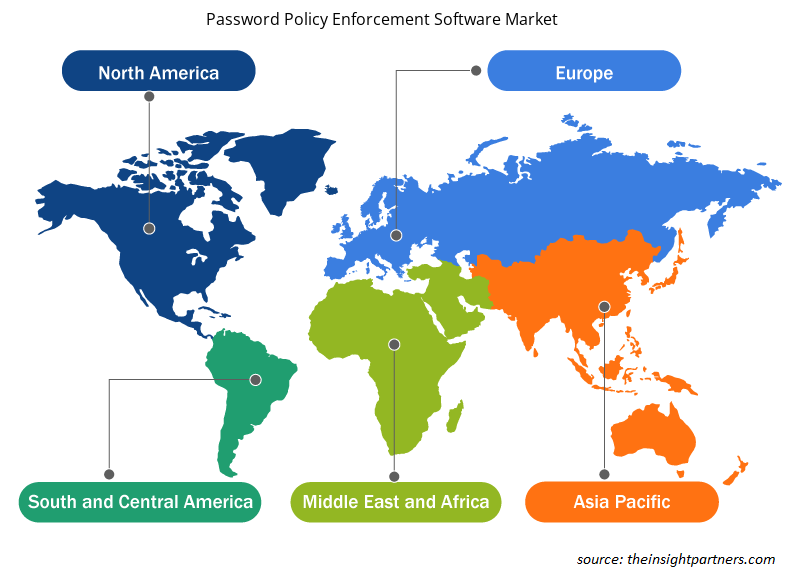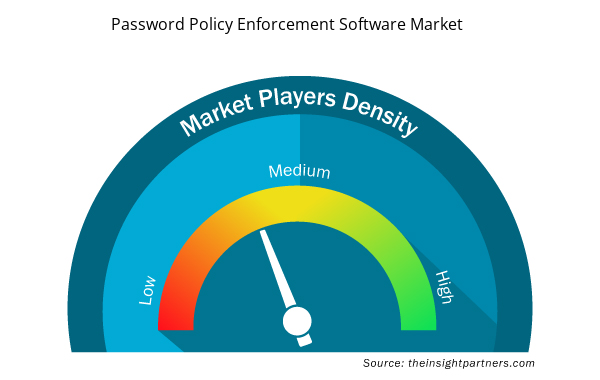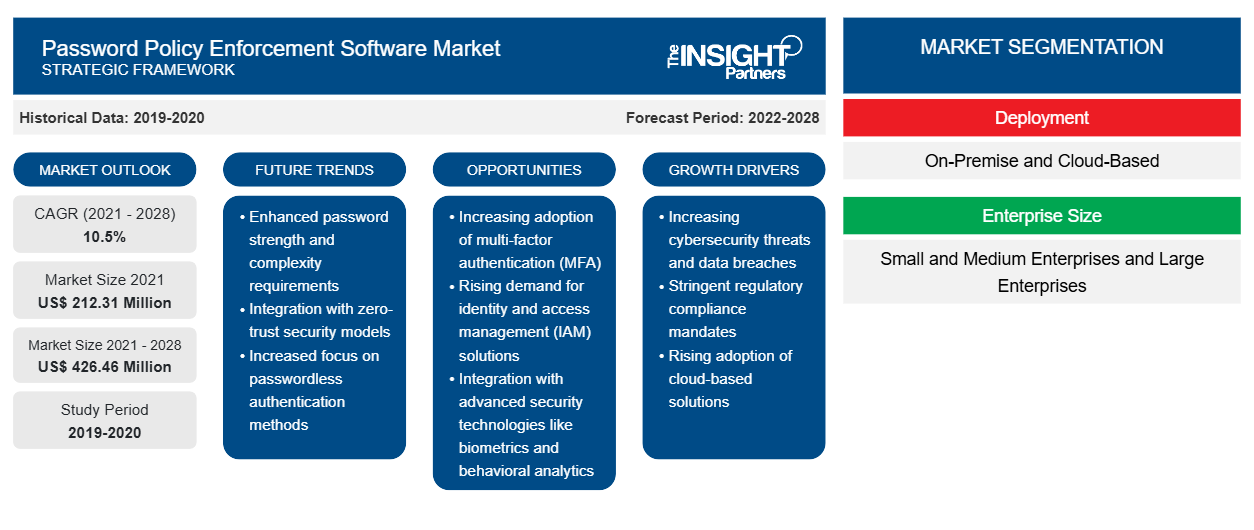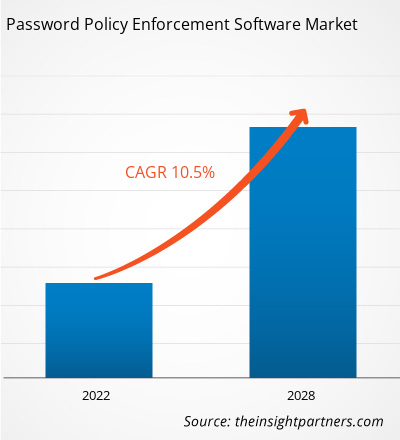Il mercato del software per l'applicazione delle policy sulle password è stato valutato a 212,31 milioni di dollari nel 2021 e si prevede che raggiungerà i 426,46 milioni di dollari entro il 2028. Si prevede che crescerà a un CAGR del 10,5% dal 2021 al 2028.
Le soluzioni software per l'applicazione delle policy sulle password assicurano che vengano utilizzate password complesse su tutte le piattaforme di un'azienda. Le organizzazioni installano software per l'applicazione delle policy sulle password per consentire agli utenti correlati di creare password che soddisfino le restrizioni delle policy sulle password aziendali in termini di complessità delle password, simboli, numeri, lettere maiuscole e minuscole, caratteri minimi e massimi. Le restrizioni assicurano inoltre che le password non contengano parole, frasi o password comunemente utilizzate, parole inserite nella blacklist specificata dall'azienda o password provenienti da dizionari di hacking noti.
Diversi fornitori digitali sono entrati nel mercato del software di applicazione delle policy sulle password con offerte semplificate per vari settori verticali industriali. Ad esempio, Netwrix Corporation fornisce un software di applicazione delle policy sulle password semplificato che soddisfa anche le esigenze più complicate in materia di policy sulle password consentendo a utenti, gruppi di dominio e unità organizzative di specificare fino a 256 regole per password locali e di dominio.
Il Nord America è uno dei mercati più importanti per il mercato del software di applicazione delle policy sulle password. Inoltre, si prevede che i continui miglioramenti delle tecnologie nei domini di analisi, cloud e tendenze BYOD forniranno al mercato regionale una spinta importante. Inoltre, un aumento della frequenza degli attacchi informatici ha suscitato preoccupazioni sulla sicurezza delle password, contribuendo alla crescita del mercato del software di applicazione delle policy sulle password.
Personalizza questo report in base alle tue esigenze
Riceverai la personalizzazione gratuita di qualsiasi report, comprese parti di questo report, o analisi a livello nazionale, pacchetto dati Excel, oltre a usufruire di grandi offerte e sconti per start-up e università
- Scopri le principali tendenze di mercato in questo rapporto.Questo campione GRATUITO includerà analisi di dati che spaziano dalle tendenze di mercato alle stime e alle previsioni.
Impatto della pandemia di COVID-19 sul mercato dei software per l'applicazione delle policy sulle password
L'enorme diffusione del SARS-CoV-2 ha spinto i governi di diversi paesi a imporre severe restrizioni alla circolazione di veicoli e persone. I conseguenti divieti di viaggio, blocchi di massa e chiusure aziendali emanati dai governi hanno influenzato le economie e le industrie di vari paesi, soprattutto nel 2020. L'imposizione del blocco ha anche ridotto la produzione di materie prime, beni e servizi. Al contrario, la pandemia di COVID-19 ha contribuito alla crescita del mercato dei software di applicazione delle policy sulle password nel 2020, poiché milioni di dipendenti sono stati invitati dalle loro aziende a lavorare da remoto. Seguire tali misure di protezione standard ha portato a una crescita nell'utilizzo di reti di terze parti, piattaforme digitali e dispositivi di elaborazione personali. Tali soluzioni di connettività di rete aumentano i rischi di violazioni dei dati e altri malware. A causa dell'aumento del rischio di reati informatici, le aziende cercano software di applicazione delle policy sulle password per rilevare e gestire qualsiasi comportamento anomalo nelle reti.
Market Insights – Mercato del software per l'applicazione delle policy sulle password
Progressi nel mercato dei software per l'applicazione delle policy sulle password
Sebbene vi sia una tendenza crescente verso metodi di autenticazione alternativi, le password stanno trovando una soluzione per "coesistere" e le password sono necessarie per il prossimo futuro. Prima che soluzioni sofisticate possano essere facilmente implementate, le password esistenti devono essere integrate con standard più recenti, come la biometria e l'autenticazione multifattoriale . Il fatto che le password non siano abbastanza forti da essere indipendenti non ne indebolisce l'importanza in termini di sicurezza. Quindi, anche se le password stanno per scomparire, le aziende dovrebbero attenersi alle proprie policy e garantire che il personale adotti un'igiene delle password. Le password vengono utilizzate per accedere alla tecnologia. Grazie a tecnologie come il Touch ID di Apple, il movimento senza password ha raggiunto un punto di svolta tecnologico: la tecnologia sta progredendo e i clienti sono stati preparati per l'autenticazione biometrica . I vantaggi delle configurazioni senza password vanno oltre i fattori di forma fisici. Gli utenti possono identificarsi tramite il viso, il tocco o la voce, ma i sistemi possono ora includere identificatori spaziali. L'analisi comportamentale è più difficile da compromettere e meno scomoda per l'utente.
Inoltre, gli utenti risponderanno sempre negativamente alla mancanza di familiarità o ai costi extra percepiti quando viene implementato un nuovo sistema di sicurezza. Tuttavia, l'autenticazione a due fattori e multifattoriale sta diventando sempre più popolare e sta dando i suoi frutti per chi la usa. Pertanto, si prevede che i progressi nel software di applicazione delle policy sulle password guideranno la crescita del mercato del software di applicazione delle policy sulle password nel prossimo futuro.
Informazioni basate sulla distribuzione
In base al tipo di distribuzione, il mercato del software per l'applicazione delle policy sulle password può essere suddiviso in on-premise e basato su cloud. Ci sono numerose considerazioni da considerare nel mondo IT aziendale odierno prima di decidere se un'infrastruttura cloud sia la soluzione perfetta. D'altro canto, molte aziende non sono in grado di effettuare la transizione al cloud, affidandosi invece ai loro collaudati sistemi e software legacy e on-premise per condurre gli affari.
Informazioni basate sulle dimensioni aziendali
In base alle dimensioni aziendali, il mercato del software per l'applicazione delle policy sulle password è suddiviso in piccole e medie imprese e grandi imprese. Le piccole e medie imprese (PMI) sono aziende con ricavi, asset o personale inferiori a una determinata soglia. Le piccole e medie imprese (PMI) sono definite in modo diverso in ogni paese. Le PMI svolgono un ruolo fondamentale nell'economia, nonostante le loro piccole dimensioni. Sono molto più numerose delle grandi aziende, impiegano un'enorme forza lavoro e sono imprenditoriali, contribuendo a dare forma all'innovazione.
Approfondimenti regionali sul mercato del software per l'applicazione delle policy sulle password
Le tendenze regionali e i fattori che influenzano il mercato del software per l'applicazione delle policy sulle password durante il periodo di previsione sono stati ampiamente spiegati dagli analisti di Insight Partners. Questa sezione discute anche i segmenti del mercato del software per l'applicazione delle policy sulle password e la geografia in Nord America, Europa, Asia Pacifico, Medio Oriente e Africa e Sud e Centro America.

- Ottieni i dati specifici regionali per il mercato del software di applicazione delle policy sulle password
Ambito del rapporto di mercato sul software per l'applicazione delle policy sulle password
| Attributo del report | Dettagli |
|---|---|
| Dimensioni del mercato nel 2021 | 212,31 milioni di dollari USA |
| Dimensioni del mercato entro il 2028 | 426,46 milioni di dollari USA |
| CAGR globale (2021 - 2028) | 10,5% |
| Dati storici | 2019-2020 |
| Periodo di previsione | 2022-2028 |
| Segmenti coperti | Per distribuzione
|
| Regioni e Paesi coperti | America del Nord
|
| Leader di mercato e profili aziendali chiave |
|
Densità dei player del mercato del software per l'applicazione delle policy sulle password: comprendere il suo impatto sulle dinamiche aziendali
Il mercato del software per l'applicazione delle policy sulle password sta crescendo rapidamente, spinto dalla crescente domanda degli utenti finali dovuta a fattori quali l'evoluzione delle preferenze dei consumatori, i progressi tecnologici e una maggiore consapevolezza dei vantaggi del prodotto. Con l'aumento della domanda, le aziende stanno ampliando le loro offerte, innovando per soddisfare le esigenze dei consumatori e capitalizzando sulle tendenze emergenti, il che alimenta ulteriormente la crescita del mercato.
La densità degli operatori di mercato si riferisce alla distribuzione di aziende o società che operano in un particolare mercato o settore. Indica quanti concorrenti (operatori di mercato) sono presenti in un dato spazio di mercato in relazione alle sue dimensioni o al valore di mercato totale.
Le principali aziende che operano nel mercato del software per l'applicazione delle policy sulle password sono:
- Gestisci motore
- Avieri
- Sistemi ID Hitachi Inc.
- Società per azioni Netwrix
- Società di sicurezza nFront Inc.
Disclaimer : le aziende elencate sopra non sono classificate secondo un ordine particolare.

- Ottieni la panoramica dei principali attori del mercato del software per l'applicazione delle policy sulle password
Gli operatori che operano nel mercato dei software per l'applicazione delle policy sulle password si concentrano principalmente sullo sviluppo di prodotti avanzati ed efficienti.
- Nel 2021, Netwrix ha acquisito PolicyPak per ampliare la propria offerta con la sicurezza degli endpoint. Si prevede che questa acquisizione rafforzerà il portafoglio prodotti di Netwrix ed estenderà la sua sicurezza e il controllo sugli account privilegiati ai desktop nei prossimi anni. PolicyPak e Netwrix insieme offrono soluzioni alle organizzazioni per la sicurezza contro attacchi informatici e hacker.
- A settembre 2020, ManageEngine ha annunciato che ADSelfService Plus supporta ora l'autenticazione a più fattori per proteggere le organizzazioni da qualsiasi accesso non autorizzato ai propri dati.
Mercato globale del software per l'applicazione delle policy sulle password: profili delle aziende
- Avieri
- Sistemi di identificazione Hitachi, Inc.
- Società per azioni Netwrix
- nFront Security, Inc.
- safepass.io
- Software di Specops
- Tools4ever (Gestore della complessità delle password (PCM))
- Zoho Corp (ManageEngine)
- JumpCloud Inc.
- Enzoico.
- Analisi storica (2 anni), anno base, previsione (7 anni) con CAGR
- Analisi PEST e SWOT
- Valore/volume delle dimensioni del mercato - Globale, regionale, nazionale
- Industria e panorama competitivo
- Set di dati Excel



Report Coverage
Revenue forecast, Company Analysis, Industry landscape, Growth factors, and Trends

Segment Covered
This text is related
to segments covered.

Regional Scope
North America, Europe, Asia Pacific, Middle East & Africa, South & Central America

Country Scope
This text is related
to country scope.
Domande frequenti
The global password policy enforcement software market was dominated by the large enterprises segment in 2020. Large enterprises are known to invest in innovative and latest technologies to operate their business effectively. With the growing capabilities of Password Policy Enforcement Software market tools across various industries, adoption of these tools has gained traction over the past few years. Large enterprises are utilizing various analytical tools such as Password Policy Enforcement Software, to effectively streamline the business operations.
The major companies in password policy enforcement software market includes Enzoic; Avatier; Specops Software; Safepass.me; and Zoho Corp (MANAGEENGINE).
In 2020, North America led the market with a substantial revenue share, followed by Europe and Asia Pacific. Asia Pacific is a prospective market for password policy enforcement software market manufacturers.
The global password policy enforcement software market was dominated by the cloud-based deployment segment in 2020. The key element attributed to the segmental growth is the high availability of cloud-based password policy enforcement software to keep vital business systems operating safely despite single component failures. Due to ongoing monitoring, geo-redundancy, and failover mechanisms, the cloud-based data and apps are ready to serve the workforce.
Businesses are progressively implementing security measures such as monitored accounts to improve responsibility. Such shift toward internet-based service offerings is driving the need for password policy enforcement software. Further, the need to comply with tight compliance standards and the rising risk of data theft in the BFSI, healthcare, and public sectors, among others, is further driving the password policy enforcement market.
Rising use of password blacklist or dictionary hack provide the opportunity for the password policy enforcement software solution providers. A well-designed system can check billions of passwords in milliseconds without impacting the user experience. It may also be good to divide the blacklist between passwords that have been disclosed in recent data breaches and those that are regularly found in cracking dictionaries.
Trends and growth analysis reports related to Technology, Media and Telecommunications : READ MORE..
The List of Companies - Password Policy Enforcement Software Market
- ManageEngine
- Avatier
- Hitachi ID Systems Inc.
- Netwrix Corporation
- nFront Security Inc.
- safepass.me
- Specops Software
- Tools4ever
- JumpCloud Inc.
- Enzoic
The Insight Partners performs research in 4 major stages: Data Collection & Secondary Research, Primary Research, Data Analysis and Data Triangulation & Final Review.
- Data Collection and Secondary Research:
As a market research and consulting firm operating from a decade, we have published and advised several client across the globe. First step for any study will start with an assessment of currently available data and insights from existing reports. Further, historical and current market information is collected from Investor Presentations, Annual Reports, SEC Filings, etc., and other information related to company’s performance and market positioning are gathered from Paid Databases (Factiva, Hoovers, and Reuters) and various other publications available in public domain.
Several associations trade associates, technical forums, institutes, societies and organization are accessed to gain technical as well as market related insights through their publications such as research papers, blogs and press releases related to the studies are referred to get cues about the market. Further, white papers, journals, magazines, and other news articles published in last 3 years are scrutinized and analyzed to understand the current market trends.
- Primary Research:
The primarily interview analysis comprise of data obtained from industry participants interview and answers to survey questions gathered by in-house primary team.
For primary research, interviews are conducted with industry experts/CEOs/Marketing Managers/VPs/Subject Matter Experts from both demand and supply side to get a 360-degree view of the market. The primary team conducts several interviews based on the complexity of the markets to understand the various market trends and dynamics which makes research more credible and precise.
A typical research interview fulfils the following functions:
- Provides first-hand information on the market size, market trends, growth trends, competitive landscape, and outlook
- Validates and strengthens in-house secondary research findings
- Develops the analysis team’s expertise and market understanding
Primary research involves email interactions and telephone interviews for each market, category, segment, and sub-segment across geographies. The participants who typically take part in such a process include, but are not limited to:
- Industry participants: VPs, business development managers, market intelligence managers and national sales managers
- Outside experts: Valuation experts, research analysts and key opinion leaders specializing in the electronics and semiconductor industry.
Below is the breakup of our primary respondents by company, designation, and region:

Once we receive the confirmation from primary research sources or primary respondents, we finalize the base year market estimation and forecast the data as per the macroeconomic and microeconomic factors assessed during data collection.
- Data Analysis:
Once data is validated through both secondary as well as primary respondents, we finalize the market estimations by hypothesis formulation and factor analysis at regional and country level.
- Macro-Economic Factor Analysis:
We analyse macroeconomic indicators such the gross domestic product (GDP), increase in the demand for goods and services across industries, technological advancement, regional economic growth, governmental policies, the influence of COVID-19, PEST analysis, and other aspects. This analysis aids in setting benchmarks for various nations/regions and approximating market splits. Additionally, the general trend of the aforementioned components aid in determining the market's development possibilities.
- Country Level Data:
Various factors that are especially aligned to the country are taken into account to determine the market size for a certain area and country, including the presence of vendors, such as headquarters and offices, the country's GDP, demand patterns, and industry growth. To comprehend the market dynamics for the nation, a number of growth variables, inhibitors, application areas, and current market trends are researched. The aforementioned elements aid in determining the country's overall market's growth potential.
- Company Profile:
The “Table of Contents” is formulated by listing and analyzing more than 25 - 30 companies operating in the market ecosystem across geographies. However, we profile only 10 companies as a standard practice in our syndicate reports. These 10 companies comprise leading, emerging, and regional players. Nonetheless, our analysis is not restricted to the 10 listed companies, we also analyze other companies present in the market to develop a holistic view and understand the prevailing trends. The “Company Profiles” section in the report covers key facts, business description, products & services, financial information, SWOT analysis, and key developments. The financial information presented is extracted from the annual reports and official documents of the publicly listed companies. Upon collecting the information for the sections of respective companies, we verify them via various primary sources and then compile the data in respective company profiles. The company level information helps us in deriving the base number as well as in forecasting the market size.
- Developing Base Number:
Aggregation of sales statistics (2020-2022) and macro-economic factor, and other secondary and primary research insights are utilized to arrive at base number and related market shares for 2022. The data gaps are identified in this step and relevant market data is analyzed, collected from paid primary interviews or databases. On finalizing the base year market size, forecasts are developed on the basis of macro-economic, industry and market growth factors and company level analysis.
- Data Triangulation and Final Review:
The market findings and base year market size calculations are validated from supply as well as demand side. Demand side validations are based on macro-economic factor analysis and benchmarks for respective regions and countries. In case of supply side validations, revenues of major companies are estimated (in case not available) based on industry benchmark, approximate number of employees, product portfolio, and primary interviews revenues are gathered. Further revenue from target product/service segment is assessed to avoid overshooting of market statistics. In case of heavy deviations between supply and demand side values, all thes steps are repeated to achieve synchronization.
We follow an iterative model, wherein we share our research findings with Subject Matter Experts (SME’s) and Key Opinion Leaders (KOLs) until consensus view of the market is not formulated – this model negates any drastic deviation in the opinions of experts. Only validated and universally acceptable research findings are quoted in our reports.
We have important check points that we use to validate our research findings – which we call – data triangulation, where we validate the information, we generate from secondary sources with primary interviews and then we re-validate with our internal data bases and Subject matter experts. This comprehensive model enables us to deliver high quality, reliable data in shortest possible time.


 Ottieni un campione gratuito per questo repot
Ottieni un campione gratuito per questo repot